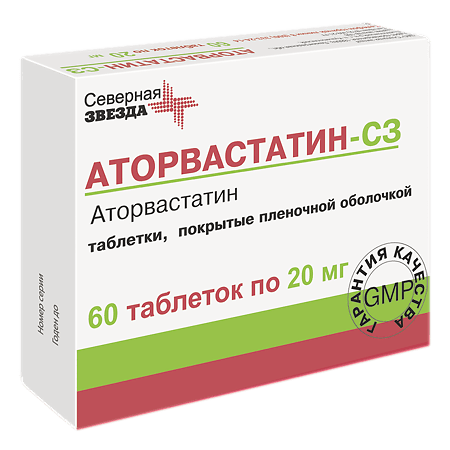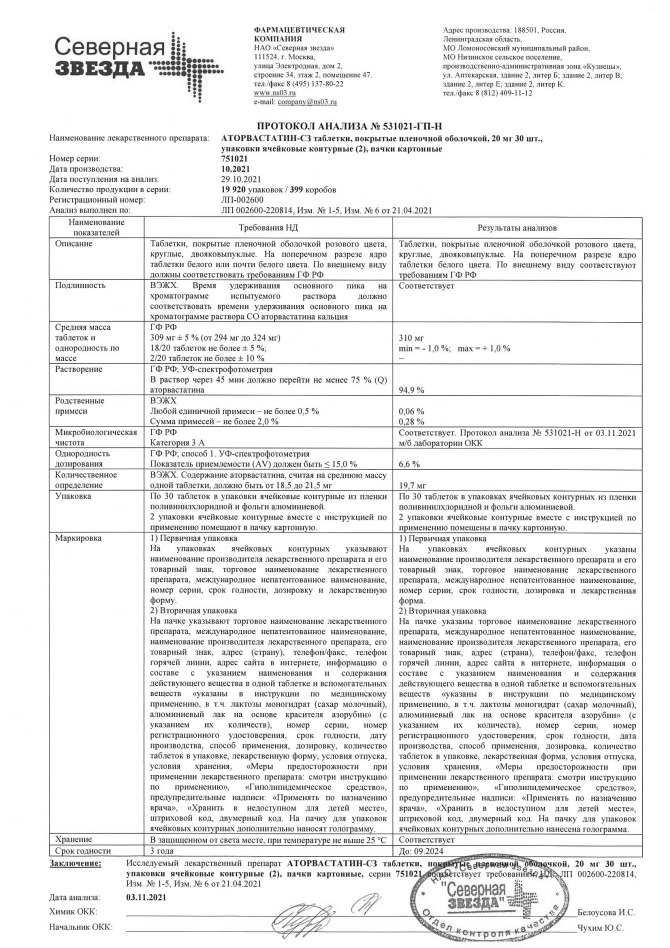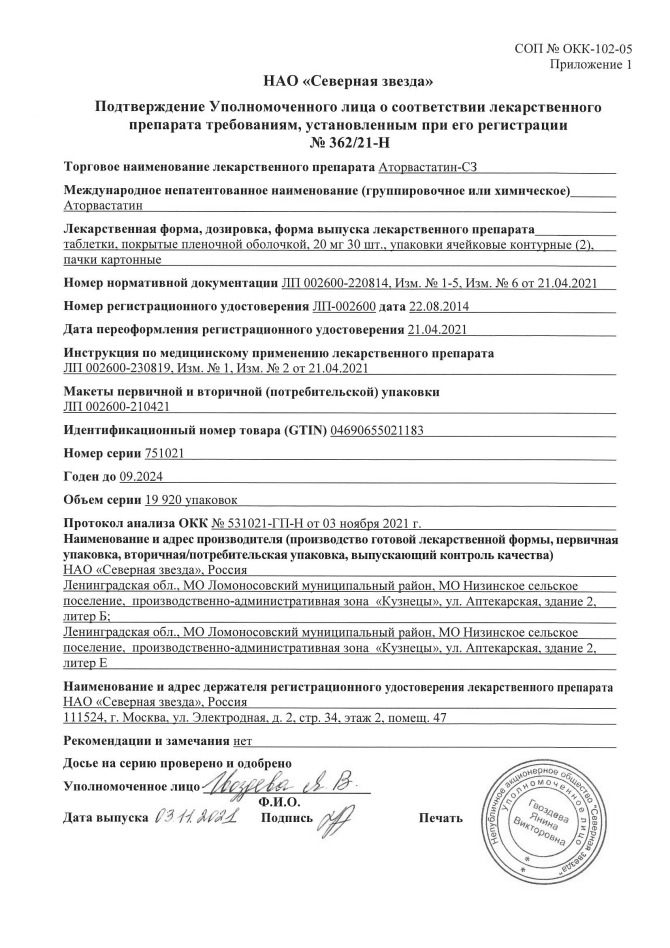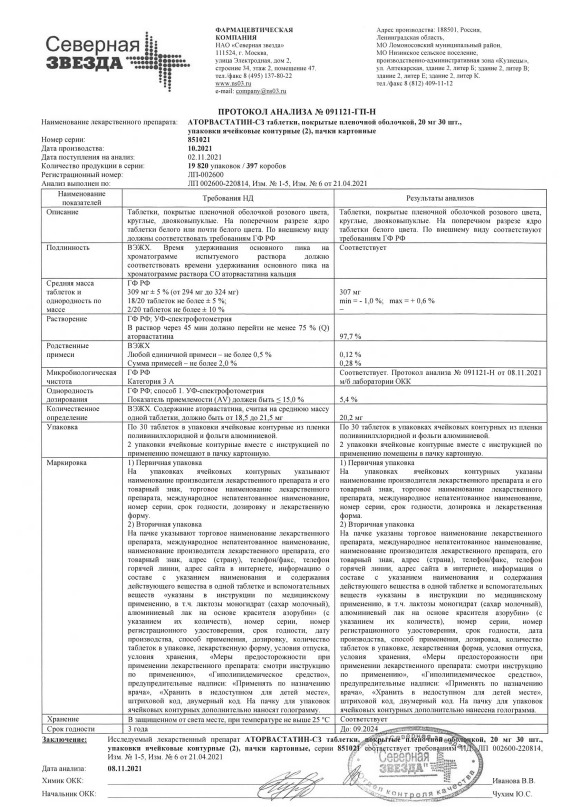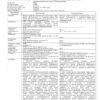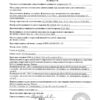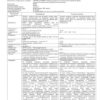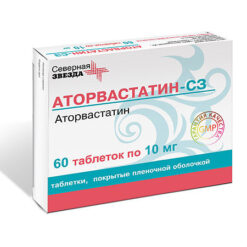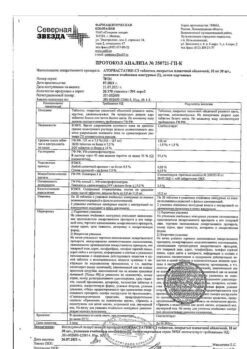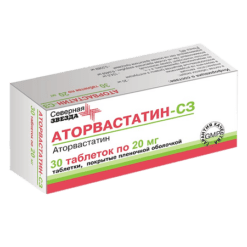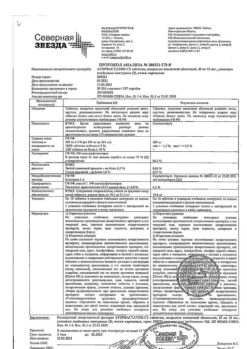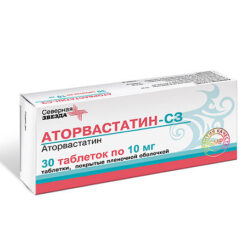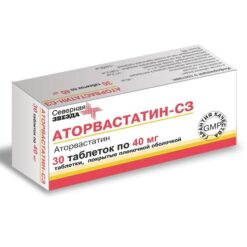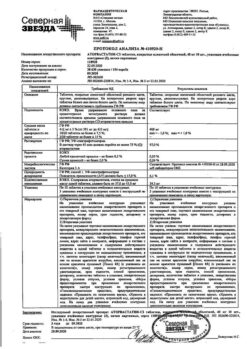No products in the cart.
Atorvastatin-SZ, 20 mg 60 pcs
€9.13 €7.99
Description
Pharmacotherapeutic drug group:
Hypolipidemic drug – HMG-CoA reductase inhibitor
ATX code: [C10AA05]
Pharmacological properties
Pharmacodynamics
Atorvastatin is a selective competitive inhibitor of HMG-CoA reductase, a key enzyme that converts 3-hydroxy-3-methylglutaryl-CoA to mevalonate, a precursor of steroids, including cholesterol; a synthetic hypolipidemic agent.
. In patients with homozygous and heterozygous familial hypercholesterolemia, nonfamilial forms of hypercholesterolemia and mixed dyslipidemia, atorvastatin reduces plasma cholesterol (CH) low density lipoprotein cholesterol (LDL-C) and apolipoprotein B (apo-B), as well as very low density lipoprotein cholesterol (VLDL-C) and triglycerides (TG), causes unstable increase in high density lipoprotein cholesterol (HDL-C). Atorvastatin reduces plasma concentrations of cholesterol and lipoproteins by inhibiting HMG-CoA reductase and cholesterol synthesis in the liver and increasing the number of “hepatic” LDL receptors on the cell surface, which leads to increased capture and catabolism of LDL-C.
Atorvastatin decreases formation of LDL-C and the number of LDL particles, causes a pronounced and sustained increase in LDL receptor activity in combination with favorable qualitative changes of LDL particles and decreases LDL-C concentration in patients with homozygous hereditary familial hypercholesterolemia resistant to therapy with other hypolipidemic agents.
Atorvastatin at doses of 10 mg to 80 mg reduces cholesterol concentration by 30% to 46%, LDL-C by 41% to 61%, apolipoprotein-b by 34% to 50% and TG by 14% to 33%. Therapy results were similar in patients with heterozygous familial hypercholesterolemia, nonfamilial forms of hypercholesterolemia and mixed hyperlipidemia, including patients with type 2 diabetes. In patients with isolated hypertriglyceridemia, atorvastatin reduces cholesterol, LDL-C, LDL-C, apo-B and TG concentrations and increases HDL-C concentration. In patients with dysbetalipoproteinemia, atorvastatin reduces the concentration of intermediate-density lipoprotein cholesterol.
In patients with hyperlipoproteinemia of type IIa and IIb according to Fredrickson classification mean increase of HDL-C concentration during treatment with atorvastatin (10-80 mg) in comparison with baseline is 5.1 % – 8.7 % and it is not dose dependent. There is a significant dose-dependent decrease of total cholesterol/CHD-LDL and LDL-C/CHD-LDL ratios by 29 % – 44 % and 37 % – 55 %, respectively. Antisclerotic effect of atorvastatin is a consequence of its effect on the vascular wall and blood components. Atorvastatin inhibits the synthesis of isoprenoids, which are growth factors of the cells of the inner membrane of blood vessels. Under the effect of atorvastatin endothelium-dependent dilation of blood vessels is improved, concentration of HDL-C, apolipoprotein B, TG is reduced, concentration of HDL-C and apolipoprotein A cholesterol is increased. Atorvastatin reduces plasma viscosity and activity of some clotting and platelet aggregation factors. Due to this it improves hemodynamics and normalizes the state of the clotting system. HMG-CoA reductase inhibitors also affect the metabolism of macrophages, block their activation and prevent the rupture of atherosclerotic plaque.
Atorvastatin-CZ at a dose of 80 mg significantly reduces the risk of coronary complications and mortality rate by 16% after a 16-week course, and the risk of readmission for angina with signs of myocardial ischemia by 26%. In patients with different baseline concentrations of LDL-C, Atorvastatin NW causes a decrease in the risk of ischemic complications and mortality (in patients with myocardial infarction without Q-wave and unstable angina, as well as in men and women, and in patients aged younger and older than 65 years). Decrease in plasma concentration of LDL-C better correlates with the drug dose than with its plasma concentration. The dose is selected taking into account the therapeutic effect (see section “Dosage and administration”). Therapeutic effect is achieved 2 weeks after the start of therapy, reaches a maximum after 4 weeks and is maintained during the entire period of therapy.
Pharmacokinetics
Eabsorption
Atorvastatin is quickly absorbed after oral administration: time of reaching its maximum concentration (TSmax) in plasma is 1-2 hours. In women maximal concentration (CMax) of atorvastatin is 20% higher and area under curve “concentration-time” (AUC) is 10% lower than in men. The degree of absorption and plasma concentration increase in proportion to the dose. Absolute bioavailability is about 14% and systemic bioavailability of HMG-CoA reductase inhibitory activity is about 30%. Low systemic bioavailability is due to presystemic metabolism in the mucosa of the gastrointestinal tract and/or during “primary passage” through the liver. Food intake reduces the rate and degree of drug absorption (by 25% and 9%, respectively), as evidenced by the results of Cmax and AUC determination, but decrease of LDL-C is similar to that of atorvastatin on an empty stomach. Despite the fact that after Atorvastatin administration in the evening its concentration in plasma is lower (Cmax and AUC, approximately by 30%) than after administration in the morning, decrease of LDL-C concentration does not depend on the time of day, when the drug is taken.
Distribution
The mean volume of distribution of atorvastatin is about 381 liters. The binding to plasma proteins is at least 98%. The ratio of content in erythrocytes/plasma is about 0.25, i.e. atorvastatin poorly penetrates into erythrocytes.
Metabolism
Atorvastatin is largely metabolized with the formation of ortho- and parahydroxylated derivatives and various β-oxidation products. In vivo ortho- and parahydroxylated metabolites have an inhibitory effect on HMG-CoA reductase comparable with that of atorvastatin. Approximately 70% of the decrease of HMG-CoA reductase activity is due to the action of active circulating metabolites. The results of in vitro studies suggest that hepatic CYPCA4 isoenzyme plays an important role in atorvastatin metabolism. This fact is supported by increased plasma concentrations of the drug with concomitant administration of erythromycin, which is an inhibitor of this isoenzyme. Studies have also shown that atorvastatin is a weak inhibitor of CYP3A4 isoenzyme. Atorvastatin has no clinically significant effect on plasma concentrations of terfenadine, which is metabolized primarily by CYPCA4 isoenzyme, therefore its significant effect on pharmacokinetics of other substrates of CYPCA4 isoenzyme is unlikely (see section “Interaction with other medicinal products”).
Atorvastatin and its metabolites are excreted mainly with bile after hepatic and/or extrahepatic metabolism (atorvastatin does not undergo marked hepatic recirculation). The half-life (T1/2) of atorvastatin is about 14 h, while its inhibitory effect against HMG-CoA reductase is approximately 70% determined by the activity of circulating metabolites and persists for about 20 – 30 hours due to their presence. After oral administration, less than 2% of the administered dose of the drug is detected in the urine.
Patient special groups
Elderly patients
Atorvastatin concentrations in plasma of patients over 65 years old are higher (Cmax
by about 40%, AUC by about 30%) than those of adult patients of younger age. No differences in efficacy and safety of the drug, or in achieving the goals of hypolipidemic therapy in elderly patients compared to the general population were found.
Children
There have been no studies of pharmacokinetics of the drug in children.
Inadequate renal function
Induced renal function has no effect on plasma concentrations of atorvastatin or its effect on lipid metabolism parameters; therefore, no dose change is required in patients with impaired renal function.
Atorvastatin is not excreted during hemodialysis due to intense binding to plasma proteins.
There have been no studies of atorvastatin use in patients with end-stage renal failure.
Liver function insufficiency
The drug concentration is significantly increased (Cmax approximately 16-fold, AUC approximately 11-fold) in patients with alcoholic cirrhosis (stage B on the Child-Pugh scale) (see section “Contraindications”).
Indications
Indications
• Primary hypercholesterolemia (heterozygous familial and non-familial hypercholesterolemia (type IIa according to the Fredrickson classification);
• Combined (mixed) hyperlipidemia (types IIa and IIb according to the Fredrickson classification);
• Disbetalipoproteinemia (type III according to the Fredrickson classification) (as an addition to the diet);
• Familial endogenous hypertriglyceridemia (type IV according to the Fredrickson classification), resistant to diet;
• Homozygous familial hypercholesterolemia with insufficient effectiveness of diet therapy and other non-pharmacological treatment methods;
• Prevention of cardiovascular diseases:
– Primary prevention of cardiovascular complications in patients without clinical signs of coronary heart disease (CHD), but with several risk factors for its development: age over 55 years, nicotine addiction, hypertension, diabetes mellitus, genetic predisposition, including dyslipidemia;
– Secondary prevention of cardiovascular complications in patients with coronary artery disease in order to reduce the total mortality rate, myocardial infarction, stroke, re-hospitalization for angina pectoris and the need for revascularization.
Pharmacological effect
Pharmacological effect
Pharmacotherapeutic group of the drug:
Lipid-lowering agent – HMG-CoA reductase inhibitor
ATX code: [S10AA05]
Pharmacological properties
Pharmacodynamics
Atorvastatin is a selective competitive inhibitor of HMG-CoA reductase, a key enzyme that converts 3-hydroxy-3-methylglutaryl-CoA into mevalonate, a precursor of steroids, including cholesterol; synthetic lipid-lowering agent.
In patients with homozygous and heterozygous familial hypercholesterolemia, non-familial forms of hypercholesterolemia and mixed dyslipidemia, atorvastatin reduces the plasma concentrations of cholesterol (C), low-density lipoprotein cholesterol (LDL-C) and apolipoprotein B (apo-B), as well as very low-density lipoprotein cholesterol (VLDL-C) and triglycerides (TG), causes an unstable increase in the concentration of high-density lipoprotein cholesterol (HDL-C). Atorvastatin reduces the concentration of cholesterol and lipoproteins in the blood plasma by inhibiting HMG-CoA reductase and cholesterol synthesis in the liver and increasing the number of “liver” LDL receptors on the cell surface, which leads to increased uptake and catabolism of LDL-C.
Atorvastatin reduces the formation of LDL-C and the number of LDL particles, causes a pronounced and persistent increase in the activity of LDL receptors in combination with favorable qualitative changes in LDL particles, and also reduces the concentration of LDL-C in patients with homozygous hereditary familial hypercholesterolemia, resistant to therapy with other lipid-lowering drugs.
Atorvastatin in doses from 10 mg to 80 mg reduces the concentration of cholesterol by 30% – 46%, LDL-C by 41% – 61%, apolipoprotein-B by 34% – 50% and TG by 14% – 33%. The results of therapy are similar in patients with heterozygous familial hypercholesterolemia, non-familial forms of hypercholesterolemia and mixed hyperlipidemia, including patients with type 2 diabetes mellitus. In patients with isolated hypertriglyceridemia, atorvastatin reduces the concentration of cholesterol, LDL-C, VLDL-C, apo-B and TG and increases the concentration of HDL-C. In patients with dysbetalipoproteinemia, atorvastatin reduces the concentration of intermediate-density lipoprotein cholesterol.
In patients with hyperlipoproteinemia types IIa and IIb according to the Fredrickson classification, the average increase in HDL-C concentration during treatment with atorvastatin (10-80 mg) compared to baseline is 5.1% – 8.7% and is independent of dose. There is a significant dose-dependent decrease in the ratios: total cholesterol/HDL-C and LDL-C/HDL-C by 29% – 44% and 37% – 55%, respectively. The antisclerotic effect of atorvastatin is a consequence of its effect on the walls of blood vessels and blood components. Atorvastatin inhibits the synthesis of isoprenoids, which are growth factors for the cells of the inner lining of blood vessels. Under the influence of atorvastatin, endothelium-dependent dilatation of blood vessels improves, the concentration of LDL-C, apolipoprotein B, and TG decreases, and the concentration of HDL-C and apolipoprotein A increases. Atorvastatin reduces the viscosity of blood plasma and the activity of some coagulation factors and platelet aggregation. Thanks to this, it improves hemodynamics and normalizes the state of the coagulation system. HMG-CoA reductase inhibitors also affect the metabolism of macrophages, block their activation and prevent rupture of atherosclerotic plaque.
Atorvastatin-SZ at a dose of 80 mg significantly reduces the risk of ischemic complications and mortality by 16% after a 16-week course, and the risk of re-hospitalization for angina pectoris accompanied by signs of myocardial ischemia by 26%. In patients with different baseline LDL-C concentrations, Atorvastatin-SZ causes a reduction in the risk of ischemic complications and mortality (in patients with non-Q wave myocardial infarction and unstable angina, as well as in men and women, and in patients younger and older than 65 years). The decrease in plasma LDL-C concentration correlates better with the dose of the drug than with its plasma concentration. The dose is selected taking into account the therapeutic effect (see section “Method of administration and dosage”). The therapeutic effect is achieved 2 weeks after the start of therapy, reaches a maximum after 4 weeks and persists throughout the entire period of therapy.
Pharmacokinetics
Suction
Atorvastatin is rapidly absorbed after oral administration: the time to reach its maximum concentration (TCmax) in the blood plasma is 1-2 hours. In women, the maximum concentration (Cmax) of atorvastatin is 20% higher, and the area under the concentration-time curve (AUC) is 10% lower than in men. The degree of absorption and plasma concentration increase in proportion to the dose. Absolute bioavailability is about 14%, and systemic bioavailability of inhibitory activity against HMG-CoA reductase is about 30%. Low systemic bioavailability is due to first-pass metabolism in the mucous membrane of the gastrointestinal tract and/or during “first pass” through the liver. Eating reduces the rate and extent of drug absorption (by 25% and 9%, respectively), as evidenced by the results of determining Cmax and AUC, but the reduction in LDL-C is similar to that when taking atorvastatin on an empty stomach. Despite the fact that after taking atorvastatin in the evening, its plasma concentration is lower (Cmax and AUC by approximately 30%) than after taking it in the morning, the decrease in LDL-C concentration does not depend on the time of day at which the drug is taken.
Distribution
The mean volume of distribution of atorvastatin is approximately 381 L. Communication with blood plasma proteins is not less than 98%. The erythrocyte/blood plasma ratio is about 0.25, i.e. atorvastatin penetrates erythrocytes poorly.
Metabolism
Atorvastatin is extensively metabolized to form ortho- and parahydroxylated derivatives and various β-oxidation products. In vitro, ortho- and parahydroxylated metabolites have an inhibitory effect on HMG-CoA reductase comparable to that of atorvastatin. Approximately 70% of the decrease in HMG-CoA reductase activity occurs due to the action of active circulating metabolites. The results of in vitro studies suggest that the liver isoenzyme CYP3A4 plays an important role in the metabolism of atorvastatin. This fact is supported by an increase in the concentration of the drug in the blood plasma while taking erythromycin, which is an inhibitor of this isoenzyme. In vitro studies also showed that atorvastatin is a weak inhibitor of the CYP3A4 isoenzyme. Atorvastatin does not have a clinically significant effect on the plasma concentration of terfenadine, which is metabolized mainly by the CYP3A4 isoenzyme, so its significant effect on the pharmacokinetics of other CYP3A4 isoenzyme substrates is unlikely (see section “Interaction with other drugs”).
Removal
Atorvastatin and its metabolites are excreted mainly in bile after hepatic and/or extrahepatic metabolism (atorvastatin does not undergo significant enterohepatic recirculation). The half-life (T1/2) of atorvastatin is about 14 hours, while the inhibitory effect of the drug on HMG-CoA reductase is approximately 70% determined by the activity of circulating metabolites and persists for about 20-30 hours due to their presence. After oral administration, less than 2% of the administered dose of the drug is found in the urine.
Special patient groups
Elderly patients
Plasma concentrations of atorvastatin in patients over 65 years of age are higher (Cmax
approximately 40%, AUC approximately 30%) than in young adult patients. There were no differences in the efficacy and safety of the drug, or the achievement of lipid-lowering therapy goals in elderly patients compared with the general population.
Children
Pharmacokinetic studies of the drug have not been conducted in children.
Kidney failure
Impaired renal function does not affect the plasma concentration of atorvastatin or its effect on lipid metabolism, and therefore no dose adjustment is required in patients with impaired renal function.
Atorvastatin is not excreted during hemodialysis due to intense binding to plasma proteins.
There have been no studies of atorvastatin in patients with end-stage renal disease.
Liver failure
The concentration of the drug is significantly increased (Cmax approximately 16 times, AUC approximately 11 times) in patients with alcoholic cirrhosis (stage B on the Child-Pugh scale) (see section “Contraindications”).
Special instructions
Special instructions
Before starting Atorvastatin therapy, the patient must be prescribed a standard cholesterol-lowering diet, which he must follow during the entire treatment period.
The use of HMG-CoA reductase inhibitors to reduce blood lipid levels can lead to changes in biochemical parameters reflecting liver function. Liver function should be monitored before starting therapy, 6 weeks, 12 weeks after starting Atorvastatin and after each dose increase, and periodically, for example, every 6 months. An increase in the activity of liver enzymes in the blood serum may be observed during therapy with Atorvastatin. Patients who experience elevated enzyme levels should be monitored until enzyme levels return to normal. If alanine aminotransferase (ALT) or aspartic aminotransferase (AST) values are more than 3 times the upper acceptable limit, it is recommended to reduce the dose of Atorvastatin or discontinue treatment.
Atorvastatin should be used with caution in patients who abuse alcohol and/or have liver disease. Active liver disease or persistent increases in aminotransferase activity of unknown origin are contraindications to the use of Atorvastatin.
Treatment with Atorvastatin may cause myopathy. The diagnosis of myopathy (muscle pain and weakness in combination with an increase in creatine phosphokinase (CPK) activity more than 10 times the upper limit of normal) should be considered in patients with widespread myalgia, muscle soreness or weakness, and/or a marked increase in CPK activity. Patients should be warned that they should immediately tell their doctor if they experience unexplained muscle pain or weakness if they are accompanied by malaise or fever.
Atorvastatin therapy should be discontinued in the event of a marked increase in CPK activity or in the presence of confirmed or suspected myopathy. The risk of myopathy during treatment with other drugs in this class was increased with concomitant use of cyclosporine, fibrates, erythromycin, niacin, or azole antifungals. Many of these drugs inhibit cytochrome P450 3A4-mediated metabolism and/or drug transport. Atorvastatin is biotransformed by CYP 3A4.
When prescribing Atorvastatin in combination with fibrates, erythromycin, immunosuppressive agents, azole antifungals or nicotinic acid in lipid-lowering doses, the expected benefits and risks of treatment should be carefully weighed and patients should be regularly monitored for muscle pain or weakness, especially during the first months of treatment and during periods of increasing dosage of any drug. In such situations, periodic determination of CPK activity can be recommended, although such monitoring does not prevent the development of severe myopathy.
When using Atorvastatin, as well as other drugs of this class, cases of rhabdomyolysis with acute renal failure caused by myoglobinuria have been described. Atorvastatin therapy should be temporarily discontinued or completely discontinued if signs of possible myopathy appear or if there is a risk factor for the development of renal failure due to rhabdomyolysis (for example, severe acute infection, hypotension, major surgery, trauma, severe metabolic, endocrine and electrolyte disturbances, and uncontrolled seizures).
Before starting Atorvastatin therapy, an attempt should be made to control hypercholesterolemia through adequate dietary therapy, increased physical activity, weight loss in obese patients, and treatment of other conditions.
Patients should be warned to seek immediate medical attention if they experience unexplained muscle pain or weakness, especially if accompanied by malaise or fever.
Active ingredient
Active ingredient
Atorvastatin
Composition
Composition
1 film-coated tablet contains:
active substance:
atorvastatin calcium in terms of atorvastatin – 20 mg
excipients (core):
lactose monohydrate (milk sugar) – 124.0 mg;
calcium carbonate – 66.0 mg;
povidone K 30 (medium molecular weight polyvinylpyrrolidone) – 12.0 mg;
croscarmellose sodium (primellose) – 13.5 mg;
sodium stearyl fumarate – 3.0 mg;
colloidal silicon dioxide (Aerosil) – 1.5 mg;
microcrystalline cellulose – 60.0 mg;
excipients (shell):
Opadry II (polyvinyl alcohol, partially hydrolyzed – 3.96 mg; macrogol (polyethylene glycol) 3350 – 1.1115 mg; talc – 1.8 mg; titanium dioxide E 171 – 1.7253 mg; soy lecithin E 322 – 0.315 mg; aluminum varnish based on indigo carmine dye – 0.0054 mg; aluminum varnish based on azorubine dye – 0.0459 mg; aluminum varnish based on crimson dye [Ponceau 4R] – 0.0369 mg).
Contraindications
Contraindications
Hypersensitivity to any component of the drug.
Active liver disease or an increase in the activity of “liver” transaminases in the blood plasma of unknown origin by more than 3 times compared with the upper limit of normal.
Age under 18 years (insufficient clinical data on the effectiveness and safety of the drug in this age group).
Lactose intolerance, lactase deficiency, glucose-galactose malabsorption.
Hypersensitivity to soy and peanuts.
Pregnancy and breastfeeding period.
Use in women planning pregnancy and not using reliable methods of contraception.
With caution:
Alcohol abuse, history of liver disease, diseases of the muscular system (history of the use of other representatives of the group of HMG-CoA reductase inhibitors), severe disturbances of water&electrolyte balance, endocrine (hyperthyroidism) and metabolic disorders, severe acute infections (sepsis), arterial hypotension, diabetes mellitus, uncontrolled epilepsy, extensive surgical interventions, trauma.
Side Effects
Side Effects
World Health Organization (WHO) classification of the incidence of side effects: very common (≥1/10), common (≥1/100 to <1/10), uncommon (≥1/1000 to <1/100), rare (≥1/10,000 to <1/1000), very rare (<1/10,000, including isolated reports), frequency unknown - adverse reactions with an unknown frequency (cannot be calculated from the available data).
From the nervous system: often – headache, insomnia, dizziness, paresthesia, asthenic syndrome; infrequently – peripheral neuropathy, amnesia, hypoesthesia, nightmares.
From the organ of hearing: infrequently – tinnitus.
From the cardiovascular system: palpitations, symptoms of vasodilation, migraine, postural hypotension, increased blood pressure, phlebitis, arrhythmia.
From the hematopoietic system: infrequently – thrombopytopenia.
From the respiratory system: rarely – nasopharyngitis, nosebleeds.
From the digestive system: often – constipation, dyspepsia, nausea, diarrhea, flatulence (bloating), abdominal pain; uncommon – impaired taste perception, vomiting, pancreatitis, belching; rarely – hepatitis, cholestatic jaundice; very rarely – liver failure.
From the urinary system: often – urinary tract infections; infrequently – secondary renal failure.
From the reproductive system and mammary gland: infrequently – decreased potency.
From the musculoskeletal system: often – myalgia, arthralgia, swelling of the joints; uncommon – myopathy, muscle cramps; rarely – myositis, rhabdomyolysis, tendonopathy (in some cases with tendon rupture).
From the skin of subcutaneous tissues: often – skin rash, itching; infrequently – alopecia.
Allergic reactions: infrequently – urticaria; very rarely – angioedema, bullous rash, erythema multiforme, Stevens-Johnson syndrome, toxic epidermal necrolysis, anaphylaxis;
From laboratory parameters: infrequently – increased activity of AST, ALT, increased activity of serum CPK, leukocyturia; very rarely – hyperglycemia, hypoglycemia.
Other: often – peripheral edema, chest pain, back pain; infrequently – weakness, increased fatigue, fever, anorexia, weight gain, the appearance of a “veil” before the eyes.
The following adverse effects have been reported in post-marketing use of statins: memory loss or decrease, depression, sexual dysfunction, gynecomastia, increased concentrations of glycosylated hemoglobin, isolated cases of interstitial lung disease (especially with long-term use), cases of immune-mediated necrotizing myopathy.
The cause-and-effect relationship of some undesirable effects with the use of the drug Atorvastatin-SZ, which are regarded as “very rare,” has not been established.
If severe adverse effects occur, use of the drug Atorvastatin-SZ should be discontinued.
Interaction
Interaction
The risk of myopathy during treatment with HMG-CoA reductase inhibitors increases with simultaneous use of cyclosporine, fibrates, antibiotics (erythromycin, clarithromycin, quinupristin/dalfopristin), nefazodone, HIV protease inhibitors (indinavir, ritonavir), colchicine, azole derivative antifungals, and nicotinic acid in lipid-lowering doses (more than 1 g/day) (see section “Special instructions”).
CYP3A4 isoenzyme inhibitors
Since atorvastatin is metabolized by the CYP3A4 isoenzyme, the combined use of atorvastatin with inhibitors of the CYP3A4 isoenzyme may lead to an increase in the concentration of atorvastatin in the blood plasma. The degree of interaction and potentiation effect are determined by the variability of the effect on the CYP3A4 isoenzyme.
Inhibitors of the transport protein OATP1B1
Atorvastatin and its metabolites are substrates of the transport protein OATP1B1. OATP1B1 inhibitors (eg, cyclosporine) may increase the bioavailability of atorvastatin. Thus, the combined use of atorvastatin at a dose of 10 mg and cyclosporine at a dose of 5.2 mg/kg/day leads to an increase in the concentration of atorvastatin in the blood plasma by 7.7 times. If simultaneous use with cyclosporine is necessary, the dose of Atorvastatin-SZ should not exceed 10 mg/day (see section “Dosage and Administration”).
Erythromycin/clarithromycin
With the simultaneous use of atorvastatin and erythromycin (500 mg 4 times a day) or clarithromycin (500 mg 2 times a day), which inhibit the CYP3A4 isoenzyme, an increase in the concentration of atorvastatin in the blood plasma was observed (see section “Special instructions”). Caution should be used to use the lowest effective dose of atorvastatin when coadministered with clarithromycin.
Protease inhibitors
The simultaneous use of atorvastatin with protease inhibitors, known as CYP3A4 isoenzyme inhibitors, is accompanied by an increase in the concentration of atorvastatin in the blood plasma (when used simultaneously with erythromycin, the Cmax of atorvastatin increases by 40%).
Combination of protease inhibitors
Patients taking HIV protease inhibitors and hepatitis C inhibitors should use caution and use the lowest effective dose of atorvastatin. In patients taking telaprevir or the tipranavir/ritonavir combination, the dose of Atorvastatin-SZ should not exceed 10 mg/day.
Patients taking the HIV protease inhibitor tipranavir plus ritonavir or the hepatitis C protease inhibitor telaprevir should avoid concomitant use of Atorvastatin-SZ. For patients taking the HIV protease inhibitors lopinavir plus ritonavir, caution should be exercised when prescribing Atorvastatin-SZ and the lowest dose required should be prescribed. In patients taking the HIV protease inhibitors saquinavir plus ritonavir, darunavir plus ritonavir, fosamprenavir, or fosamprenavir plus ritonavir, the dose of Atorvastatin-SZ should not exceed 20 mg and the drug should be used with caution. In patients taking the HIV protease inhibitor nelfinavir or the hepatitis C protease inhibitor boceprevir, the dose of Atorvastatin-SZ should not exceed 40 mg and close clinical monitoring is recommended.
Diltiazem
The combined use of atorvastatin at a dose of 40 mg with diltiazem at a dose of 240 mg leads to an increase in the concentration of atorvastatin in the blood plasma.
Ketoconazole, spironolactone and cimetidine
Caution should be exercised when atorvastatin is used concomitantly with drugs that reduce the concentration of endogenous steroid hormones, such as ketoconazole, spironolactone and cimetidine.
Itraconazole
Concomitant use of atorvastatin in doses from 20 mg to 40 mg and itraconazole in a dose of 200 mg led to an increase in the AUC value of atorvastatin. Caution should be used to use the lowest effective dose of atorvastatin when coadministered with itraconazole.
Grapefruit juice
Since grapefruit juice contains one or more components that inhibit the CYP3A4 isoenzyme, excessive consumption (more than 1.2 L per day) may cause an increase in plasma concentrations of atorvastatin.
Inducers of the CYP3A4 isoenzyme
The combined use of atorvastatin with inducers of the CYP3A4 isoenzyme (for example, efavirenz, phenytoin or rifampicin) may lead to a decrease in the concentration of atorvastatin in the blood plasma. Due to the dual mechanism of interaction with rifampicin (an inducer of the CYP3A4 isoenzyme and an inhibitor of the hepatocyte transport protein OATP1B1), simultaneous use of atorvastatin and rifampicin is recommended, since delayed administration of atorvastatin after taking rifampicin leads to a significant decrease in the concentration of atorvastatin in the blood plasma.
Antacids
Simultaneous oral administration of a suspension containing magnesium hydroxide and aluminum hydroxide reduced the concentration of atorvastatin in the blood plasma by approximately 35%, but the degree of reduction in the concentration of LDL-C did not change.
Phenazone
Atorvastatin does not affect the pharmacokinetics of phenazone, so interaction with other drugs metabolized by the same cytochrome isoenzymes is not expected.
Colestipol
With simultaneous use of colestipol, the concentration of atorvastatin in the blood plasma decreased by approximately 25%; however, the lipid-lowering effect of the combination of atorvastatin and colestipol was superior to that of each drug alone.
Digoxin
With repeated administration of digoxin and atorvastatin at a dose of 10 mg, the equilibrium concentrations of digoxin in the blood plasma did not change. However, when using digoxin in combination with atorvastatin at a dose of 80 mg/day. digoxin concentration increased by approximately 20%.
Patients receiving digoxin in combination with atorvastatin require appropriate monitoring.
Azithromycin
With simultaneous use of atorvastatin at a dose of 10 mg 1 time per day and azithromycin at a dose of 500 mg 1 time per day, the concentration of atorvastatin in the blood plasma did not change.
Oral contraceptives
When atorvastatin was coadministered with an oral contraceptive containing norethisterone and ethinyl estradiol, significant increases in the AUC of norethisterone and ethinyl estradiol by approximately 30% and 20%, respectively, were observed. This effect should be taken into account when choosing an oral contraceptive for a woman taking atorvastatin.
Terfenadine
With simultaneous use of atorvastatin and terfenadine, no clinically significant changes in the pharmacokinetics of terfenadine were detected.
Warfarin
Concomitant use of atorvastatin with warfarin may increase the effect of warfarin on blood coagulation parameters (decreased prothrombin time) in the first days. This effect disappears after 15 days of simultaneous use of these drugs.
Amlodipine
With simultaneous use of atorvastatin at a dose of 80 mg and amlodipine at a dose of 10 mg, the pharmacokinetics of atorvastatin at steady state did not change.
Other concomitant therapy
In clinical studies, atorvastatin was used in combination with antihypertensive agents and estrogens as part of replacement therapy; there were no signs of clinically significant adverse interactions; No interaction studies with specific drugs have been conducted.
Overdose
Overdose
In case of overdose, the following general measures are necessary: monitoring and maintaining vital functions of the body, as well as preventing further absorption of the drug (gastric lavage, taking activated charcoal or laxatives).
Storage conditions
Storage conditions
In a dry place, protected from light, at a temperature not exceeding 25 ° C.
Shelf life
Shelf life
3 years.
Manufacturer
Manufacturer
North Star NAO, Russia
Additional information
| Shelf life | 3 years. |
|---|---|
| Conditions of storage | In a dry, light-protected place at a temperature not exceeding 25 ° C. |
| Manufacturer | North Star NAO, Russia |
| Medication form | pills |
| Brand | North Star NAO |
Other forms…
Related products
Buy Atorvastatin-SZ, 20 mg 60 pcs with delivery to USA, UK, Europe and over 120 other countries.

